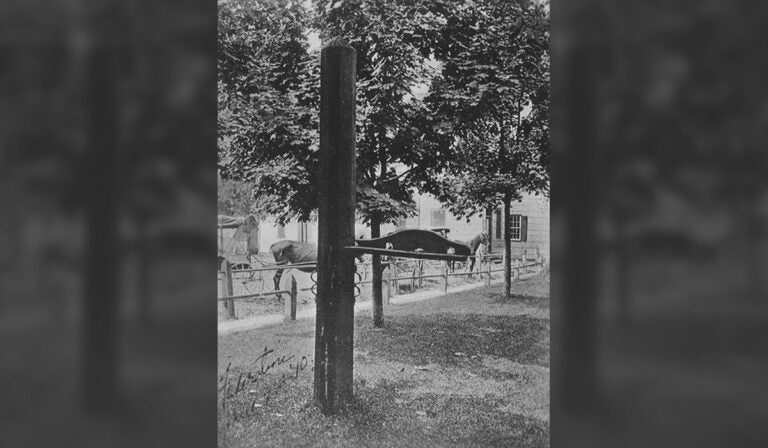‘Another example of hatred’: Whipping post to be removed from display in Delaware
Delaware was the last state to abolish the use of the whipping post as a form of legal punishment in 1972. Now the final remaining post on public display will be removed.

The whipping post in Georgetown, seen here in photo from the Delaware Public Archives, had been on display in the center of town since 1993. It will be taken down as of July 1. (courtesy Delaware Public Archives)
Dr. Reba Hollingsworth can still remember when the quiet of the crowd was broken by the piercing crack of a whip. She was 10 or 11 years old in the late 1930s when she witnessed a man beaten at a whipping post in Dover.
“The crowd was very, very quiet, and each time, all the silence just seemed to be pierced with the lashing of the whip,” she said. “I remember my dad was very quiet about it afterwards, it really affected all of us emotionally.”
Hollingsworth, who is now vice-chair of the Delaware Heritage Commission, said when the post was put back on display in the 1990s, “it was like another insult.”
Now, after public demand including a Change.org petition, the state Division of Historical and Cultural Affairs says it will remove the post.
“Taking it down removes another example of hatred,” Hollingsworth said.
Delaware was the final state to ban whippings nearly 50 years ago. In 1992, the warden of the Sussex Correctional Institution near Georgetown donated the post to the state Division of Historical and Cultural Affairs (HCA). In 1993, it was installed as a public display outside the Old Sussex County Courthouse near the Circle in the center of Georgetown.
The last whipping administered under court order in Delaware happened in 1952, but whippings remained a legal form of punishment under state law until 1972. Those found guilty of breaking and entering, stealing a horse, and embezzlement or fraud could be whipped.
According to the book “Red Hannah: Delaware’s Whipping Post,” more than 1,600 people were whipped for crimes in Delaware between 1900 and 1945. Author Robert Caldwell, who once led the University of Delaware’s sociology department, said nearly 70% of those whipped were Black, even though Black residents made up less than 20% of the state’s population during that period. The posts were originally painted red, which led to them being nicknamed “Red Hannah.”

“Finally, Delaware is removing its last ‘Red Hannah,’ the whipping post, from the public’s view,” Hollingworth said. “Such relics of the past should be placed in museums to be preserved and protected for those who want to remember the cruel, inhuman, barbarous acts perpetrated on our citizens.”
HCA will work with historians, educators and leaders in the Black community to determine how to display the post in a museum setting, where it can be properly contextualized and interpreted.
“It is appropriate for an item like this to be preserved in the state’s collections, so that future generations may view it and attempt to understand the full context of its historical significance,” said HCA Director Tim Slavin. “It’s quite another thing to allow a whipping post to remain in place along a busy public street — a cold, deadpan display that does not adequately account for the traumatic legacy it represents, and that still reverberates among communities of color in our state.”
WHYY is your source for fact-based, in-depth journalism and information. As a nonprofit organization, we rely on financial support from readers like you. Please give today.






